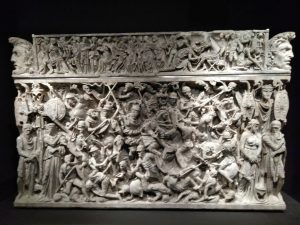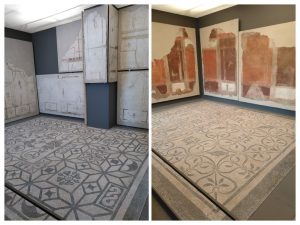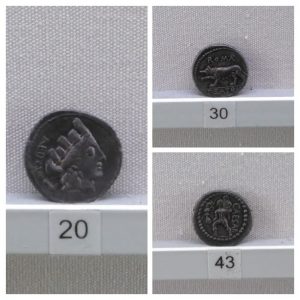This month’s post has been written by Brittany Stone, M.A. student in Roman History and Archaeology at the University of Kent.
Rome can be a very overwhelming city for tourists as there are so many places to visit. The most visited are usually historical and archaeological sites: the Vatican, Roman Forum and Colosseum are what draw over four million people to this city each year. However, these are not the only spots sought by tourists – Rome provides them with a prodigious number of museums, as well as parks and gardens. One location that deserves attention is the National Roman Museum as it is not a typical gallery and should definitely not be missed. Instead of being located in a single building, its collection is spread out throughout the city in four different sites, giving tourists the chance to see other areas of Rome.
Four separate museums (the Baths of Diocletian, the Crypta Balbi, the Palazzo Altemps and the Palazzo Massimo) have been combined to become the National Roman Museum. While the Baths of Diocletian and the Crypta Balbi are ancient Roman archaeological sites, the Palazzo Altemps and the Palazzo Massimo focus on artistic expressions of Roman history, with a special concentration on statuary and sculptures. Out of the four spaces, the Palazzo Massimo tends to be overlooked despite housing one of the largest and most significant archaeological and ancient art collections of the Graeco-Roman world. The Palazzo Massimo is conveniently located next to the Termini railway station in an unassuming building on a street corner, across the street from the Baths of Diocletian. The museum’s drab design and proximity to more familiar sites adds to the fact that it is so often ignored.
As previously mentioned, the Palazzo Massimo is not a typical museum. Its arrangement of artistry is meant to impress and recreate ancient lifestyles. The Palazzo Massimo’s collection highlights ancient art and its four floors are stuffed with artefacts; each floor operating with its own unique style, focus and purpose. On the ground floor, the museum houses an impressive collection of statues: Greek originals found within Rome as well as Roman copies of Greek originals, with a focus on Roman busts from the late Republican era to the Augustan age. The next floor up continues with sculpture but in greater numbers and varies wildly in design and style, from busts to sarcophagi. At the top of the museum, the collection shifts from sculptures to frescoes, stuccos, and mosaics. Lastly, the basement houses an eclectic collection of Roman everyday artefacts (jewellery, jars and coins in particular) from across the centuries.
The museum’s prized masterpieces are displayed on the ground floor. Ranging from Greek bronze to Roman marble, this floor notably displays famous statues such as The Boxer, the Hellenistic Prince, and Augustus from the Via Labicana. Nevertheless, the statue that caught my eye was Aphrodite by the sculptor Menophantos from the first century BCE. Her pose suggests that she is in the process of covering herself, hiding her naked body from unwanted eyes in a pose reminiscent of Praxiteles’ famous fourth century BCE sculpture Aphrodite of Knidos.
Figure 1: Aphrodite of Menophantos
Rooms Five to Ten illustrate the statuary decorations of wealthy villas from the imperial age, including the Sleeping Hermaphroditus. I found the artistic value of this statue perfectly emphasized by the museum as the statue is cleverly laid with its backside to the visitor entrance. While admiring the sensual line of the figure’s form, visitors believe it to be a female but after walking around to the front of the piece, they discover with surprise it is a man. In Greek mythology, Hermaphroditus was born of Hermes and Aphrodite with both sexes’ genitals, which is brilliantly exhibited here as it blends gendered perspectives into one form. This version is believed to be a copy of an original mostly likely created in the second century BCE.
Figure 2: The Sleeping Hermaphroditus
When continuing along the first floor, the collection impressively presents official Roman art pieces that commemorate historical events, on the verge of political propaganda. The work that stands out the most is the sarcophagus of the subjugation of barbarian peoples under the Romans. In its own room and expertly spotlit, this sarcophagus, and the painstaking detail of its craftsmanship, is meant to noticed and admired. Dated to around 180 CE, its style is heavily influenced by the Column of Marcus Aurelius and reflects scenes of the Marcomanni Wars. For some unknown reason, the faces of the dead individuals for whom it was intended, a man and his wife, are not completed. Even so, the rest of the sarcophagus is a work of wonder and illustrative of the Roman values of the time.
Figure 3: Barbarian Sarcophagus
What makes the Palazzo Massimo stand out is also its collection of frescoes and mosaics from Roman and Latin villas that have been reconstructed within the museum itself. Following the eruption of Mount Vesuvius in 79 CE, Roman towns like Pompeii and Herculaneum were preserved in situ and contribute to our understanding of early imperial villas and urban life. The villa reconstructions in the museum offer an elegant substitution for this original context. Nevertheless, they are not exact replicas. Instead, the museum has placed frescoes on the walls and mosaics on the floor in similar positions as they would have originally been in their villas but did not go as far as to recreate hallways or roofs. Ultimately, I believe that what the Palazzo Massimo has achieved is the next best way to present these materials. The collection on the second floor is surprising and jaw-droppingly impressive.
The Palazzo Massimo’s collection on the second floor is considerable, with displays of mosaics recreated along the walls of hallways and entire rooms structured with fresco walls accompanied by mosaic floors. The museum has focused the design of its second floor on Roman villas, some from within the city and others in nearby ancient Latina. Among the pieces of this exhibition, the most renowned ones are the villa of Livia, wife of Emperor Augustus, and others found beneath the modern Villa Farnesina, a villa which is potentially belonged to Augustus’ friend and son-in-law Agrippa. Whenever possible, the villa’s frescoes have been placed in their original location so that visitors can walk from room to room, creating a rare and exciting experience.
Figure 4: Fresco walls and mosaic floors
Last but certainly not least, there is the basement of the Palazzo Massimo which houses the artefacts from Roman everyday life. Room Three is a collection of grave goods, largely excavated around the city and that includes glass jars, jewellery and figurines. In addition to the funerary votives, there is the resting Grottarossa mummy of a little Roman girl from the second century CE. Embalming was practised in the city during this period but this is the only mummy of its kind, discovered in 1964 on the Via Cassia. Furthermore, this space showcases one of the largest galleries of coins, spanning 2 500 years of history in date. This collection consists of finds from the early Italic peoples to Roman Republican and Imperial currencies through the Middle Ages, all the way down to the coins of the modern era.
Figure 5: Roman Republican and Imperial coins
Rome has an abundance of artefacts and objects commemorating its ancient history as can be easily witnessed when wandering around the city itself. The National Roman Museum offers an illustrative example of this: starting from a single collection in the Baths of Diocletian that quickly outgrew its space, it is now a unique model for the display of cultural heritage. However, the nature of the museum has eluded to many visitors, even though each site is impressive in its own right.
On TripAdvisor, none of the National Roman Museums appears in the ‘Top 25 Things to Do in Rome’ list and the Palazzo Massimo comes in at #44 out of 1 964 things to do in Rome, despite the museum having a 4.5/5-star rating and over 2 000 reviews. Nevertheless, a trip to the National Roman Museum is well worth the time if you wish to discover the incredible historical culture of the city. When in Rome, a visit to the Palazzo Massimo alle Terme is a must.
SELECTED BIBLIOGRAPHY:
- Cadario Matteo and Nunzio Guistozzi. Palazzo Massimo alle Terme Guide. Ministero dei Beni e delle Attivita Culturali e del Turismo, Electra (2018).
- “National Roman Museum.” Encyclopedia Britannica (2014). Available online
- Massimo Unmissable. “The Unmissable.” National Roman Museum (2017). Available online
- Ministry of Cultural Heritage. “National Roman Museum – Palazzo Massimo.” Ministry of Cultural Heritage and Activities and Tourism. Available online
- Trip Advisor Rome. “Things to Do in Rome.” Available online




